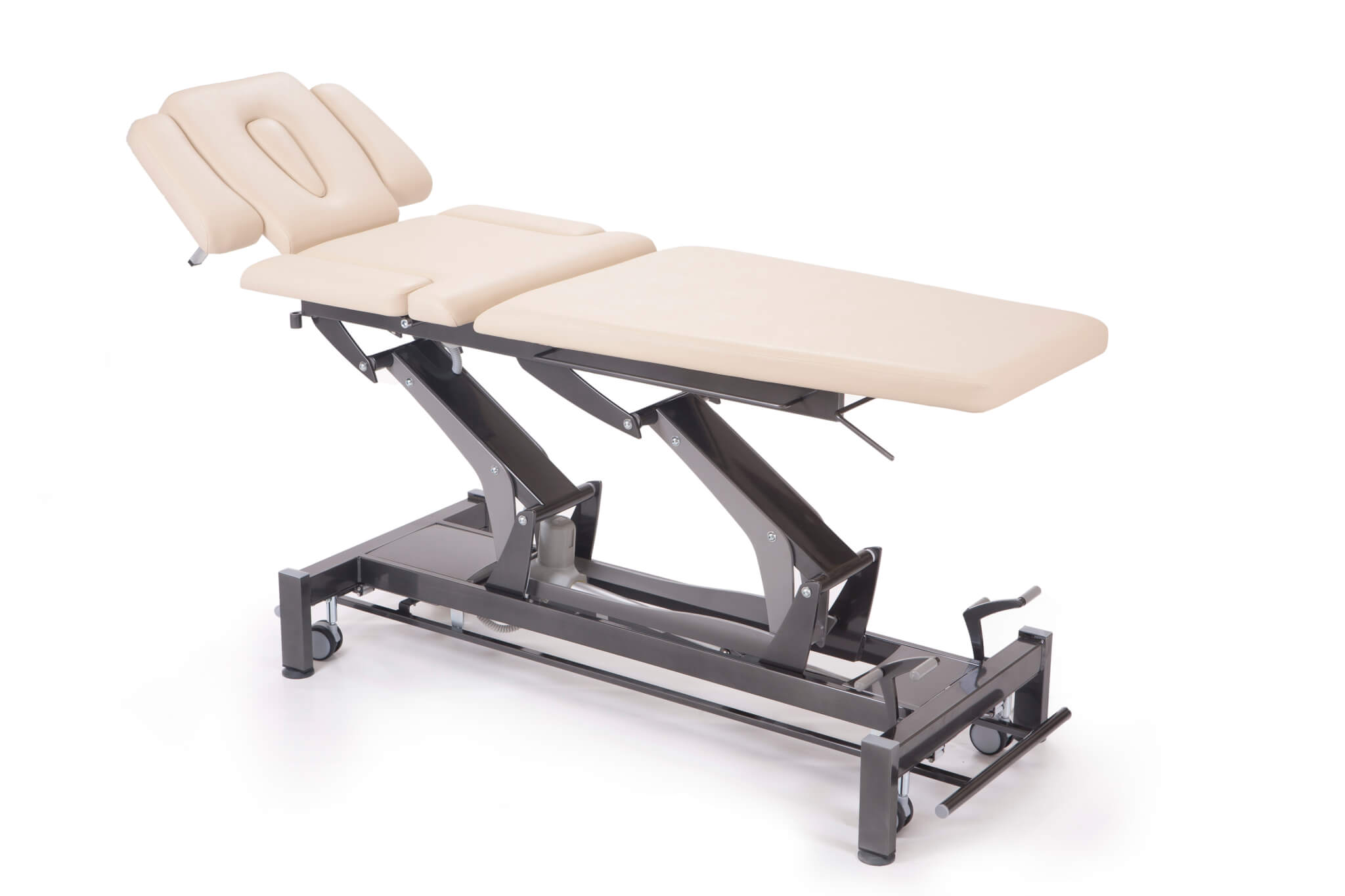10 Valuable Guidelines For Choosing a Physical Therapy Treatment Table
In this article, we will look at the role played by tables in physiotherapy and then consider guidelines to be used when selecting a physical therapy treatment table.
Introduction
Whether you operate a clinic specializing in physiotherapy, chiropractic or massage therapy, you will know that a high quality treatment table is a must have. The choice of treatment table will be one of the most important investments you will make at the outset and will play a key role in patient satisfaction and therefore in the likelihood of success or failure of your venture.
In light of the importance of this decision, we will spend the first part of this article explaining why it plays a critical role in patient satisfaction. We will then go on to suggest the important guidelines you should follow when choosing the most appropriate treatment table for your physiotherapy practice.
The Importance of the Role of a Physical Therapy Treatment Table
Physiotherapy is a vital discipline in healthcare that focuses on restoring and maintaining physical function, mobility, and overall well-being. As mentioned above, one essential component of a physiotherapy clinic is the treatment table. These specialized tables play a crucial role in facilitating effective assessment, diagnosis, and treatment techniques. In this article, we will explore the importance of treatment tables in physiotherapy and their impact on patient care and outcomes.
- Patient Comfort and Accessibility: Physical therapy treatment tables provide a comfortable and accessible platform for patients during therapy sessions. They are designed with padded surfaces, adjustable height options, and various accessories to ensure optimal patient comfort. This comfort allows patients to relax, facilitating a more effective therapeutic experience.
- Support and Stability: Treatment tables offer the necessary support and stability for patients during various physiotherapy interventions. They provide a firm surface for patients to lie, sit, or perform exercises on, ensuring proper body alignment and minimizing the risk of injury. The tables also have sturdy frames and reliable locking mechanisms to ensure stability during manual therapies or weight-bearing exercises.
- Positioning and Alignment: Correct positioning and alignment are essential in physiotherapy to target specific body areas accurately. Treatment tables with adjustable segments and features, such as headrests, backrests, or leg supports, enable physiotherapists to position patients optimally for various treatment modalities. Proper alignment enhances the effectiveness of techniques such as joint mobilization, soft tissue manipulation, or stretching exercises.
- Versatility and Adaptability: Treatment tables are designed to accommodate a wide range of physiotherapy interventions. They can be adjusted to different angles, heights, and configurations to support specific treatment techniques or patient conditions. This versatility allows physiotherapists to adapt the table to suit the unique needs of each patient, optimizing treatment outcomes.
- Safety and Hygiene: Treatment tables are designed with patient safety and hygiene in mind. They often have rounded corners, smooth edges, and non-slip surfaces to minimize the risk of accidental injuries. Many treatment tables also feature easily cleanable materials, making them hygienic and suitable for infection control protocols.
- Therapist Ergonomics: Physiotherapists often perform manual therapies or assist patients in performing exercises. Treatment tables with adjustable heights and sections help optimize therapist ergonomics, allowing them to maintain proper body mechanics and posture during treatments. This reduces the risk of strain or overexertion, enhancing the therapist’s comfort and prolonging their career longevity.
- Storage and Organization: Physical therapy treatment tables often include storage options for therapeutic equipment and supplies, such as towels, pillows, or therapeutic tools. This organization facilitates easy access to necessary items during treatment sessions, ensuring efficiency and smooth workflow for physiotherapists.
How to Choose the Best Physical Therapy Treatment Table
Choosing the right physical therapy treatment table is a crucial decision that can impact patient comfort, therapist ergonomics, and overall treatment effectiveness. Here are 10 key steps to consider when selecting the appropriate treatment table for your physical therapy practice:

- Assess Your Practice Needs: Evaluate your specific practice requirements and treatment modalities. Consider factors such as the types of patients you treat, the range of conditions you address, and the specific treatment techniques you employ. This assessment will help you determine the features and specifications you need in a physiotherapy treatment table.
- Determine Patient Considerations: Consider the diverse needs of your patients. Think about patient demographics, physical limitations, and comfort requirements. Assess whether you need features such as adjustable height, wide cushions, or weight-bearing capacity to accommodate a variety of patients and conditions.
- Evaluate Table Features and Adjustability: Look for treatment tables that offer essential features and adjustability options. Consider elements such as height adjustability, backrest and legrest adjustability, adjustable headrests, and armrests. The ability to customize the table’s configuration is crucial for proper patient positioning and therapist ergonomics.
- Consider Table Stability and Durability: Ensure that the treatment table provides stability and durability to withstand regular use and different treatment techniques. Look for a sturdy frame construction, reliable locking mechanisms, and high-quality materials that can support the weight and movements involved in physical therapy interventions.
- Assess Comfort and Padding: Patient comfort is paramount in physical therapy. Choose a treatment table with adequate padding and cushioning to provide optimal support during treatment sessions. Consider the thickness and density of the padding, as well as the overall comfort level reported by previous users or reviews.
- Review Hygiene and Maintenance Features: Maintaining a clean and hygienic treatment environment is essential. Consider treatment tables with easy-to-clean surfaces, antibacterial or antimicrobial upholstery materials, and removable cushions for cleaning. Additionally, tables with features such as seamless upholstery or water-resistant coatings can enhance hygiene protocols.
- Evaluate Portability and Storage: Consider whether portability and storage options are necessary for your practice. If you require mobility, look for treatment tables with wheels or foldable designs for easy transportation. Additionally, assess if the table offers storage options for therapeutic equipment or supplies, optimizing organization and efficiency.
- Test and Compare: Whenever possible, physically test different treatment tables before making a final decision. Assess the comfort, stability, adjustability, and overall feel of the table. If physical testing is not feasible, thoroughly review product specifications, user reviews, and ratings to gather reliable information.
- Consider Budget and Warranty: Establish a budget range for your physical therapy treatment table investment. Research different options that meet your requirements while staying within your budget. Additionally, review warranty information to ensure the manufacturer stands behind the product’s quality and provides adequate support in case of issues.
- Seek Professional Advice: Consult with other physical therapy professionals, experienced colleagues, or trusted suppliers for recommendations and insights. They can provide valuable input based on their own experiences and help guide your decision-making process.
By following these steps and considering your specific practice needs, patient requirements, and treatment techniques, you can choose a physical therapy treatment table that optimizes patient care, therapist ergonomics, and treatment outcomes. We also suggest consulting our article on how to choose a treatment table. If you already have a physical therapy treatment table and are wondering whether it’s time for a replacement, we suggest consulting this article.
Conclusion
Treatment tables are integral to the practice of physiotherapy, providing a supportive and versatile platform for assessment, diagnosis, and treatment. Their role in enhancing patient comfort, positioning, and safety cannot be overstated. By investing in high-quality treatment tables and incorporating them into physiotherapy clinics, healthcare professionals can optimize patient care, improve treatment outcomes, and create a conducive environment for both patients and therapists.



